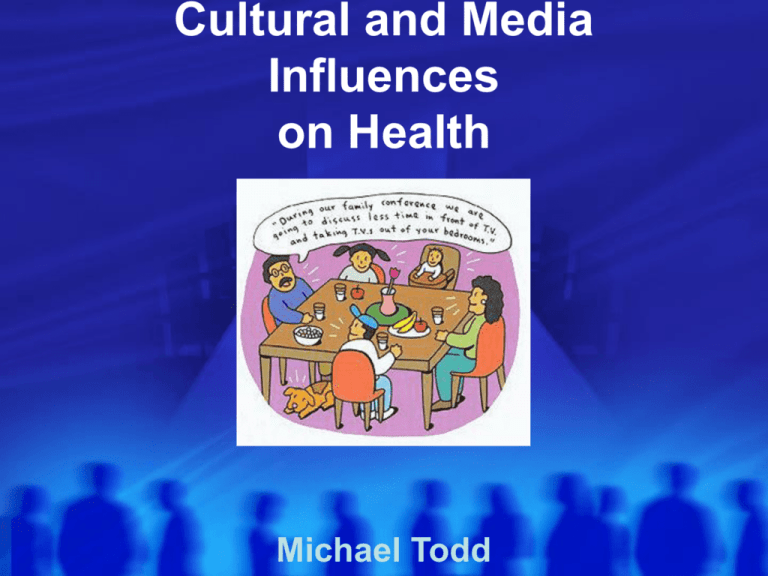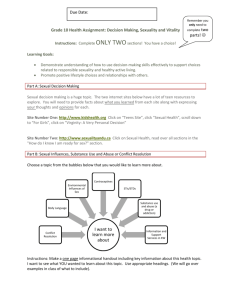PowerPoint Presentation - Cultural and Media Influences on Health
advertisement

Cultural and Media Influences on Health Michael Todd Media Influence QuickTime™ and a Sorenson Video decompressor are needed to see this picture. return Topics of Interest • Body Image • Exercise • Sexuality Body Image Below are measurements of your average adult female compared to Unrealistic body images. Average Woman Barbie Store Mannequin Height 5’4” 6’0” 6’0” Weight 145lbs 101lbs N/A Dress 11-14 4 Bust 36-37” 39” 34” Waist 29-31” 19” 23” 6 It is impossible for a woman to obtain the figure of Barbie. Celebrities Body Image Julia Roberts Height 5’9” Weight 120lbs Dress N/A Bust 34” Waist 23” Pamela Anderson 5’7” 105lbs N/A 36” 22” Jennifer Lopez 5’6” 120lbs N/A 34” 24” The above are measurements of women that you see in the media. The images that the media portray as beautiful are still unrealistic for most women. Body Image Q: What Effect does the media have on body image? A: Although the media can be a powerful tool, not everyone is affected in the same way by the same media imagery. This is usually because some people are more vulnerable then others. For example; chances are that if someone has a low self-esteem, they are more likely to compare themselves to media images, which can make them feel even lower about themselves if they feel that they do not meet the same standard of beauty that the image they are looking at is representing. Body Weight (Television) "One of the ways that the media is affecting the whole epidemic of obesity is the very heavy advertising…particularly on children's shows with fast foods, high sugar, high caloric, high fat foods, bombarding them with the message that this is the kind of food that they should be eating.“ Dr. Alvin Poussaint Television cont’d Young children don’t know anything about advertising – they think that this is the truth. “if children think that this type of food is good for you, or it makes you happy, then they want it. Advertising aimed at children is very sophisticated. Particularly with the toy tie-ins to fast food – children don’t realize they’re being marketed to. Because children are watching TV, They are also inactive. “They’re not getting exercise when they sit in front of the TV set, so they’re not burning off calories. Exercise The goal: To change body composition BMI What would the BMI say about these two guys? 6’3” 220lbs 27.5 Height Weight BMI 6’3” 220lbs 27.5 • This is a good reminder that BMI is only one piece of a persons health profile • It is important to talk with your doctor about other measures and risk factors (e.g. waist circumference, smoking, physical activity level, and diet.) Fitness Fitness people come from an athletic model (team sports, coaches, PE teachers) Fitness cont’d Questions to ponder • How do we measure someone’s fitness? Fitness testing glossary • The Performance based model? Presidential fitness testing, weight lifting marks. • Is this essential for measuring individual health? Fitness cont’d • How many of you remember Presidential Fitness testing in school? This was a test developed by those who come from a fitness model. A performance based test that measure ones fitness level, not ones health level. • How much exercise is enough? We have heard as little as 30 minutes Most days of the week. We have heard as much as 60 minutes everyday Of the week. • Truth is, these numbers come from a performance based model. • The fitness experts are trying to make you athletes, not healthy. • Truth is 20 minutes a few days of the week, will give you the same health Benefits as exercising 60 minutes everyday of the week. • Take home Message!!! We are trying to change your health, not your fitness level. Sexuality With media playing such an important role in the lives of today’s teens, it is no wonder that many of the messages about teen sexuality come directly from the media they consume. Click me Sexuality Primetime television, once considered “family hour,” is now a target for sexuality themes in both action and innuendo. A recent study by the Kaiser Family Foundation found that more than half of all television programs, excluding news, sporting events, and children’s programming, contained sexual content, incorporating an average of more than three scenes per hour. Another study by the same group found that teens believe that the media have some influence over their sexual decisions. The study found that three out of four 15-17 year olds indicated that sexual content on TV influences the behavior of their peers “somewhat” (40%) or “a lot” (32%). Not surprisingly, only one in four think it influences their own behavior. Sexuality Despite its sometimes controversial nature, abstinence remains the only sure way to avoid unwanted pregnancies or sexually transmitted diseases (STD’s). Yet, popular media rarely show teens practicing abstinence in a positive or “cool” way. Every year on television most teenagers will view about 14,000 references to sexuality, including sexual remarks, sexual innuendoes, and jokes. However, less than 5% (165) of these remarks will deal with topics such as abstinence or sexually transmitted diseases (STD’s). Conclusion • Parents need to monitor the programs that our children watch. • Children need to get answers from their parents and educators, not the media. • As adults, we need to be better aware of the media influences around us. • Be happy with who you are and send that healthy image on to our youth.







